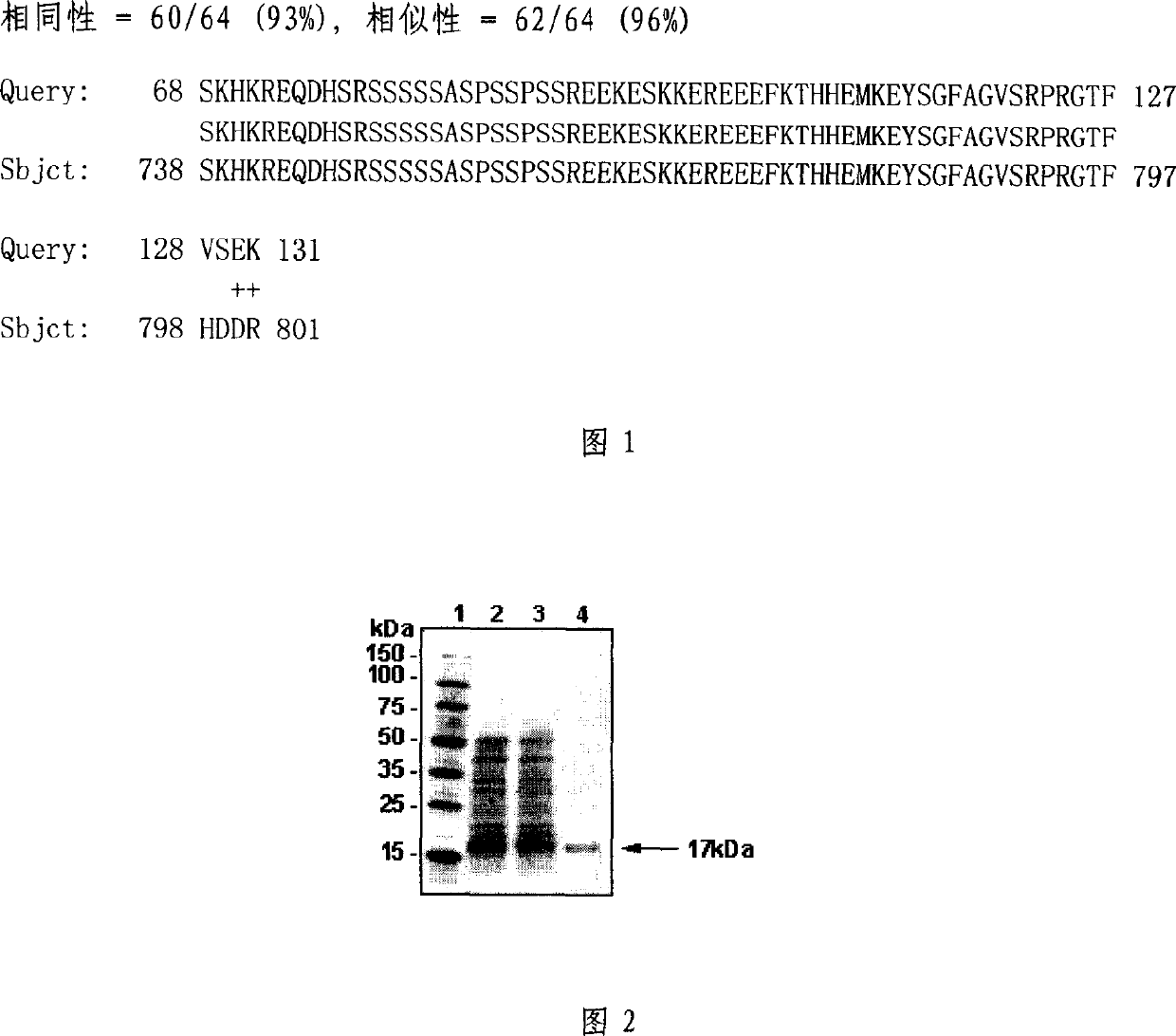Polypeptide-human transferring factor concerned with anti-withering protein-16.94 and polynucleotide for encoding it
An anti-apoptotic protein and polynucleotide technology, applied to peptide/protein components, anti-animal/human immunoglobulins, peptide sources, etc.
- Summary
- Abstract
- Description
- Claims
- Application Information
AI Technical Summary
Problems solved by technology
Method used
Image
Examples
Embodiment 1
[0120] Total RNA was extracted from human fetal brain by one-step method of guanidine isothiocyanate / phenol / chloroform. Poly(A) mRNA was isolated from total RNA using Quik mRNA Isolation Kit (product of Qiegene). 2ug poly(A) mRNA was reverse transcribed to form cDNA. Smart cDNA cloning kit (purchased from Clontech) was used to insert the cDNA fragment into the multiple cloning site of the pBSK(+) vector (product of Clontech Company), transform DH5α, and the bacteria formed a cDNA library. The sequences of the 5' and 3' ends of all clones were determined using Dyeterminate cycle reaction sequencing kit (product of Perkin-Elmer) and ABI 377 automatic sequencer (Perkin-Elmer). Comparing the determined cDNA sequence with the existing public DNA sequence database (Genebank), it was found that the cDNA sequence of one of the clones, 3053c03, was a new DNA. The insert cDNA fragment contained in this clone was determined bidirectionally by synthesizing a series of primers. The resu...
Embodiment 2
[0121] The human anti-apoptotic protein-related transcription factor-16.94 sequence of the present invention and its encoded protein sequence were used by the Blast program (Basiclocal Alignment search tool) [Altschul, SF et al.J.Mol.Biol.1990; 215: 403-10], and performed homology searches in databases such as Genbank and Swissport. The gene with the highest homology to the human anti-apoptotic protein-16.94-related transcription factor of the present invention is a known transcription factor related to the mouse anti-apoptotic protein Bcl-2, and the protein encoded by it has the access number of Genbank for AF249273. The results of protein homology are shown in Figure 1. The two are highly homologous, with an identity of 93% and a similarity of 96%. Example 3: Cloning of the gene encoding human anti-apoptotic protein-related transcription factor-16.94 by RT-PCR
Embodiment 3
[0121] The human anti-apoptotic protein-related transcription factor-16.94 sequence of the present invention and its encoded protein sequence were used by the Blast program (Basiclocal Alignment search tool) [Altschul, SF et al.J.Mol.Biol.1990; 215: 403-10], and performed homology searches in databases such as Genbank and Swissport. The gene with the highest homology to the human anti-apoptotic protein-16.94-related transcription factor of the present invention is a known transcription factor related to the mouse anti-apoptotic protein Bcl-2, and the protein encoded by it has the access number of Genbank for AF249273. The results of protein homology are shown in Figure 1. The two are highly homologous, with an identity of 93% and a similarity of 96%. Example 3: Cloning of the gene encoding human anti-apoptotic protein-related transcription factor-16.94 by RT-PCR
[0122] The total RNA of fetal brain cells was used as a template, and oligo-dT was used as a primer to carry out...
PUM
 Login to View More
Login to View More Abstract
Description
Claims
Application Information
 Login to View More
Login to View More - Generate Ideas
- Intellectual Property
- Life Sciences
- Materials
- Tech Scout
- Unparalleled Data Quality
- Higher Quality Content
- 60% Fewer Hallucinations
Browse by: Latest US Patents, China's latest patents, Technical Efficacy Thesaurus, Application Domain, Technology Topic, Popular Technical Reports.
© 2025 PatSnap. All rights reserved.Legal|Privacy policy|Modern Slavery Act Transparency Statement|Sitemap|About US| Contact US: help@patsnap.com



